JHP Newsletter - 2014, No. 2, 1 June
Greetings from northern Colorado. I've had a busy, and very productive, three months since the last Newsletter. It included my best ever visit to Yellowstone National Park where I had two amazing "firsts."Technique: Angle Finder For Wildlife
I prefer to make wildlife images from roughly the subject's eye level, and this is usually a real challenge for waterfowl and other small animals on the ground. In the past, I've just used my tripod with all legs collapsed and the legs slightly splayed. This is a pretty good solution because it gets the camera about 2 ft (60 cm) above the ground and I can sit comfortably behind the camera to wait for subjects to approach and/or demonstrate interesting behavior. The angle of view is fairly shallow when using a long lens (500mm or 600mm with a 1.4x or 2x tele-extender attached), but the camera is still considerably above most small animals. One way to get the camera lower is to splay the tripod legs completely and then lay on the ground. This is probably OK for a short time, but craning my neck to look through the viewfinder like that for an hour or more doesn't sound like fun. While spending some time in the Tonto National Forest in April, I started using my angle finder so that I could put the tripod down at ground level with all of the legs fully splayed and also sit on the ground behind the camera and look down through the angle finder to shoot. It took a while to get my hand/eye coordination down so I could quickly frame a subject, but I really like the lower perspective.
The Clark's Grebe (below L) was photographed using an angle finder and the camera about 8 in (20 cm) above the ground. The same camera settings were used for the Western Grebe (below R) that was photographed without an angle winder and the camera about 2 ft (60 cm) above the ground. The lower angle doesn't effect the look of the subject much, but boy does it help make the foreground and background disappear.
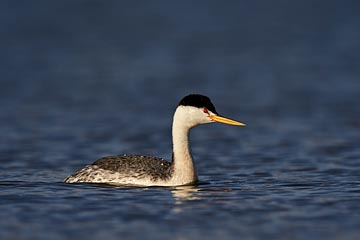
Photographed With An Angle Finder
1/1000 sec, f9.5, ISO 250
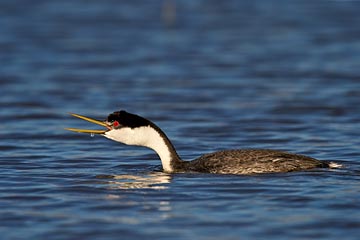
Photographed Without An Angle Finder
1/1000 sec, f9.5, ISO 250
Travel: Vermilion Cliffs, Arizona
The Vermilion Cliffs National Monument in southern Utah and northern Arizona contains many wonderful sandstone formations and is famous as the site of "The Wave" in Coyote Buttes North in Utah. Jan and I spent 12 days in the second half of February on the Arizona side in Coyote Buttes South and White Pocket.

Arizona, USA
1 & 2 sec, f11, ISO 100
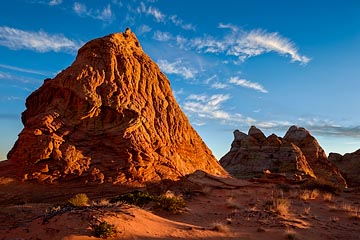
Arizona, USA
1/30, 1/15, & 1/8 sec; f11; ISO 100
Coyote Buttes South has formations made up of mostly tan and orange sandstone. These cones among orange sand (above R) were photographed at first light as I chased the clouds to make interesting compositions. Another morning I chased contrails. I usually avoid them like the plague because they scream "man-made intrusion" in the natural environment, but these roughly parallel contrails (below L), made to radiate by using an extreme wide-angle lens, create a nice background to the interesting erosion patterns in the foreground rock.
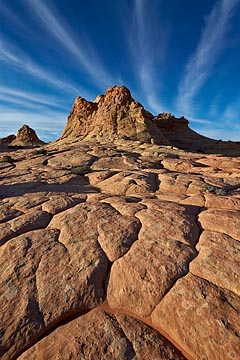
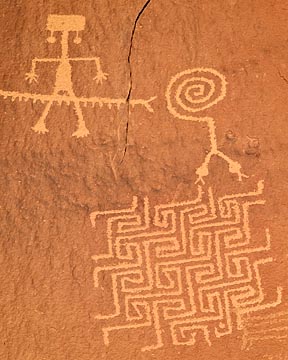
1/45 sec, f8, ISO 100
We visited the House Rock petroglyphs one afternoon, and they were spectacular! It's a large panel with lots of interesting petroglyphs. I was fascinated by the maze-like square created from separate, and similar, curved lines running diagonally (above R).
Travel: Grand Teton And Yellowstone National Parks In Winter
Jan stayed in warm Arizona and I headed to Grand Teton and Yellowstone National Parks for some winter conditions at the beginning of March. I made it just before a warming trend started to melt a lot of the snow, and was able to make some nice winter images.
There was a lot more snow on the ground in Grand Teton National Park than there was last winter, so I made very different images. During the three days I spent there, I only had good conditions for grand-landscape images one morning. I was all set to make a nice image of the Tetons proper, in the middle of the Teton Range, but the clouds didn't cooperate and blocked the nice light. However, they did let some nice light onto the top of Mt. Moran (below L). One of my favorite images of the trip is of this more intimate scene of a lone evergreen at the side of a meandering stream (below R).
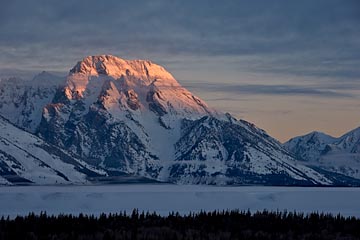
1/30 & 1/15 sec, f9.5, ISO 100
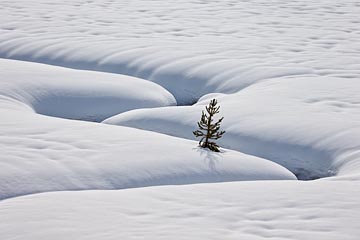
As I was leaving the Colter Bay winter camping area, also known as the parking lot near the closed-for-the-winter visitor center, I spotted this red fox (below L) resting atop a snow pile by the road. I stopped and had a blast photographing the very cooperative subject.
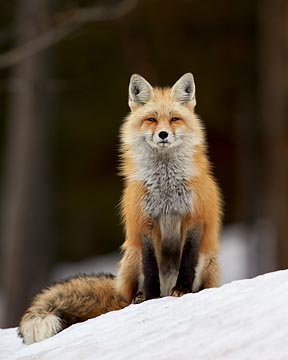
1/500 sec, f8, ISO 500

1/1500 sec, f5.6, ISO 200
I spent nine nights in Yellowstone National Park in the middle of March, just in time to catch the end of winter. One morning I spent some time with a group of bighorn sheep rams as they fed on a hillside. This guy (above R) would have been a full-curl, but the tips of his horns have been worn down, probably to help his field of view. There was frost everywhere on my second morning, and these three bison cows (below L) were in a nice line near the confluence of the Lamar River and Soda Butte Creek as the trees in the background were just starting to get full sun. I saw a lot more coyotes than usual, but most weren't very good subjects. One, however, was a spectacular subject! I found it in the afternoon after it had snowed, and it was at a nice distance from the road in a flat area with sparse vegetation poking up through the snow. In this image (below R), it's surrounded almost exclusively by snow so it really stands out.

1/750 sec, f9.5, ISO 100
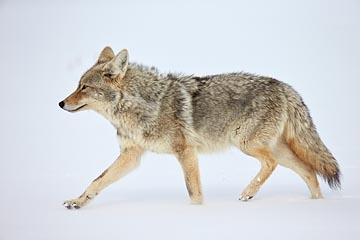
1/3000 sec, f5.6, ISO 250
Travel: Bisti Wilderness, New Mexico
I left the cold conditions in northern Wyoming and made my way south to warmer conditions. I spent a week at the end of March and the beginning of April at the Bisti Wilderness in northwest New Mexico and had a good time. It's one of my favorite landscape destinations because of the remote and fantastic badlands. It seems like there could be a composition around every corner, and this image of cracked ground (below L) jumped out at me as I was headed back to the RV one morning.

1/15 sec, f9.5, ISO 100

1/250, 1/125, 1/60, 1/30, and 1/15 sec; f13; ISO 100
I discovered this set of three wings (above R) early in my stay when I explored a new area. There was an almost-solid cloud layer at the time, so I returned on a morning when there were some nice clouds to make this much ore exciting image.
Travel: Bats In The Chiricahua Mountains, Arizona
I met up with Jan in southeastern Arizona to photograph bats in the Chiricahua Mountains for 11 days at the end of April. I was really excited to do this again after such a successful experience about four years ago. This time I had purchased and built everything necessary to do this on our own, and I was extremely disappointed that the water tank where we had planned to photograph the bats was dry when we arrived: no water, no bats coming to drink, no bat images. Not only was the tank empty, but the pipes leading to it from a small dam upstream on the adjacent stream had been disconnected, and no water was flowing out of the first pipe from the dam. Fortunately, someone had provided several sections of new pipe, so Jan and I started hauling them into place. We didn't make much progress before a thunderstorm arrived. After dinner and after the rain stopped, I went out in the dark and hooked up some of the new pipe sections to go from the dam to the last section of original pipe that emptied into the tank. I used duct tape for the joints until that ran out then I used packing tape. I was pretty sure something like this had been done on an episode of Gilligan's Island, except they didn't have to contend with cow patties and (probably) cow urine in the very shallow and aromatic slow-running stream. Unfortunately, after the plumbing work, no water flowed from the dam to the tank, but water was getting at least as far as the first connection because it was leaking slowly. I went to bed feeling very dejected. Several thunderstorms went by that night and the next morning.
After the rain stopped on that second afternoon, Jan came out with me to look at the situation. The stream was a little higher from all of the rain, but water still wasn't reaching the tank. Based on her observations, I built-up the dam to force more water into the new pipe, but still no water flowed into the tank. Then Jan suggested that maybe the pipe was like a syphon. I quickly dismissed that idea because after walking up and down the length of the pipe many times, I was quite certain that the whole length of pipe was a downhill run and wasn't like a siphon. Plus, I wasn't going to suck on the far end of the pipe knowing what was going into the pipe. Because of the possibility that the last section of original pipe, the one that emptied into the tank, was damaged or clogged, Jan helped me replace it with the final piece of new pipe and a different section of old pipe. Now we had a completely new run of pipe from the dam to the tank and still no water reached the tank. Most of the joints were leaking, so water was getting part of the way to the tank. Jan went back to the RV and I kept thinking about the situation. The last joint was leaking by this time, so water was getting almost all of the way to the tank. Maybe Jan was on to something with the siphon idea, so I took the pipe out of the tank and draped the end down in the stream bed to see if that would help. Sure enough, after a while, water started flowing out of the end of the pipe, and boy did my morale improve! It took two tries to get the pipe back up and into the tank with the water still flowing, and I was ecstatic that the tank was finally getting filled. I was also a bit embarrassed that I, with a Ph.D. in computational fluid dynamics, hadn't solved the simple plumbing problem by myself. Based on the flow rate, I expected it to take a few days to fill the tank, so I was very surprised, and thrilled, when the tank was full the next morning!
We set up to photograph the bats that evening, but the process took a little longer than I thought and we didn't capture any bats. However, something did trip the flashes while we were doing the final camera setup which was a good sign. The second night, I captured 1.5 bats. I cut off the wing tip of one bat and only got the wing of another. The third night was a charm, and I finally got some good images: three bats completely in the frame. The image of the Southwestern Myotis about to drink (below L) is my favorite image because its wings are up and it's a nice pure reflection. The image of a Southwestern Myotis after taking a drink (below R) isn't as exciting to me because of the flat wing position, but the water drops indicate what it had just done.
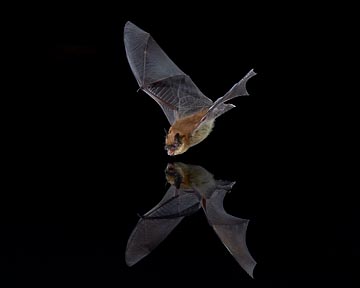
StopShot, multiple flash, 10 sec, f16, ISO 200

StopShot, multiple flash, 10 sec, f16, ISO 200
The bat photography setup at the animal watering tank is shown in the image below L, and the bats were photographed as they flew from the upper-right to the lower left. The tank's about 8 ft (2.4m) in diameter and about 2 ft (60cm) deep, and it's mostly buried in the ground. The first thing we did was lay down some black cloth across the bottom of the tank and against the far side of the tank to prevent unwanted light from reflecting through the water and picking up a green cast which is what happened when we photographed here about four years ago. Then we set up a Cognysis StopShot camera trigger with two laser beams to fire six Sunpak 383 flashes when a bat flies through either beam. The flashes were set to 1/16 power to create a very short burst of light.
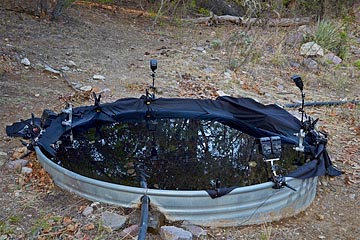
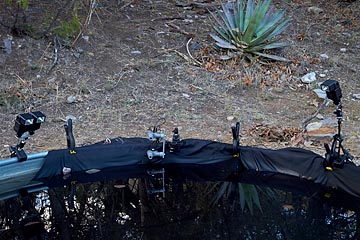
The image above R is a closer view of one side of the bat setup, and the bats were photographed as they flew right to left. The two flashes on the left provide half of the front illumination and the single flash on the right provides some rim lighting. The laser receivers are in the center. Manfrotto Superclamps, and the similar Impact Super Clamps, secure the items the rim of the tank, and the flashes are supported by small ball heads. The two main flashes are mounted next to each other on a custom flash bracket and the rim-light flash is held up higher by a fully-extended 11-inch (28cm) variable friction arm. The laser receivers are supported by an 11-inch (28cm) variable friction arm and a custom mounting plate.
The cameras were set to make 10 or 15 second exposures and set to fire repeatedly using a cable release with the button locked down. The actual image is made by the very short flash burst which illuminates the bat and stops the motion. After two or three hours of automatic and unattended operation, we returned and took down the cameras and StopShot setup. Then we looked, with great anticipation, through the mostly all-black images for the ones with a bat.
Travel: Yellowstone National Park In Spring
I returned to Yellowstone National Park for almost three weeks in the first part of May. It's my favorite time to visit the park because all the babies are making their appearance and the crowds haven't arrived. This was my best visit ever to the park and included some wonderful photo ops and two amazing "firsts."
Wolves are a big draw for may visitors to Yellowstone, but they're usually much easier to see than photograph because they're so far from the road system. On this visit, I had three close encounters and one that was also good for photography. I had followed the black wolf 926F, the alpha female of the Lamar Canyon Pack, as she and her boyfriend worked their way along the far side of the Lamar Valley towards their denning area and was in position when she crossed the road to get some nice images (below L).
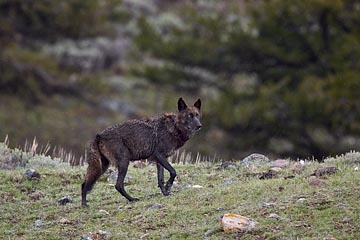
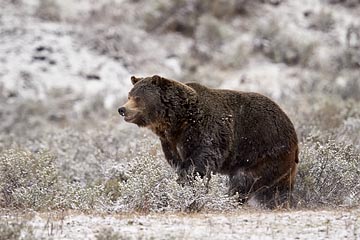
Bears are another big draw, and spring is the best time to see them as they've recently ended their hibernation and are busy eating. Early in my stay, I had several good opportunities to photograph grizzly bears. This one (above R) is running through frost-covered sagebrush after a light snow the afternoon and night before. Black bears are usually black, but are sometimes brown or cinnamon colored. Yellowstone has an unusually large percentage of not-black black bears, and this cinnamon bear (below left) gave me a nice look as it grazed on a hillside.
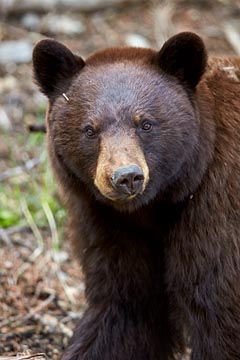
1/180 sec, f5.6, ISO 800
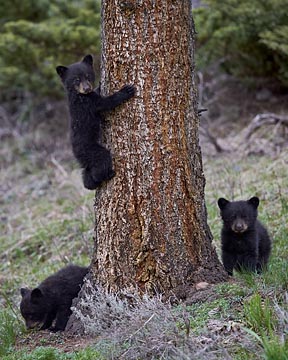
1/180 sec, f5.6, ISO 1000
Black bear cubs of the year, or spring cubs, are extremely cute, and one sow had three of them and did a great job protecting them from boars by keeping them close to the road and friendly photographers. I had several opportunities to photograph the three of them, and I just love this image of them playing around the base of a large tree (above R).
The most extraordinary photo opportunity I had was also a "first" for me --- watching and photographing a bison cow give birth. A photographer standing near me said he has been coming to the park for 44 years and has never photographed a bison giving birth. Not only was it a very rare opportunity, but it also occurred under great conditions: in short grass with nice light and very few other bison in the way. I arrived about eight minutes before the actual birth, and the cow was lying down with the calf's front legs and nose sticking out. The image below L was taken at T-00:07:15 (T minus 0 hr, 7 min, 15 sec) after the cow stood up with the calf's front legs and nose sticking out. The cow was also turned properly during the final push as the calf came tumbling out (below R).
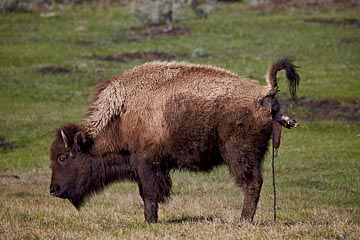
1/750 sec, f8, ISO 320

1/1000 sec, f8, ISO 400
The calf was standing without too much difficulty at T+00:11:44 and the cow continued to clean it off (below L). A little more than two hours after the calf was born, a raven flew in to see if there was anything to eat, in particular part of the afterbirth. It tried snatching the end off the piece still attached to the cow and the cow chased the raven away. The raven was determined to get something to eat and stayed in the area. At T+02:32:12, the newborn calf helped the cow chase off the raven (below R). About five minutes later, the cow and calf started moving away to join the rest of the herd that was now feeding in the sagebrush. It was an incredible 2.5 hours with them!
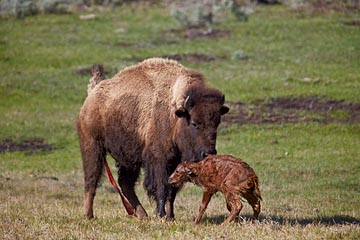
1/1000 sec, f8, ISO 400
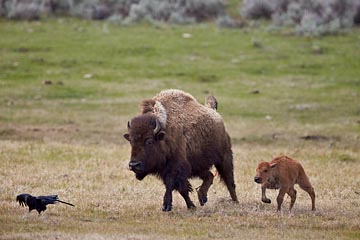
1/750 sec, f6.7, ISO 400
I also had some good opportunities to photograph elk calves, and this one is about four hours old (below L). Elk usually drop their calves in a protected area, and most in the park choose tall sagebrush to keep predators from seeing their vulnerable young. This cow also had the added protection of being right across the road from my campsite.
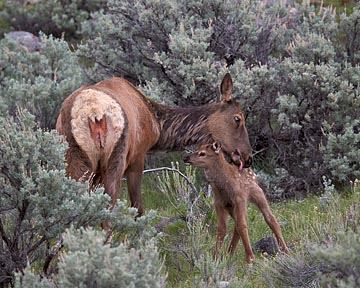
1/180 sec, f5.6, ISO 640
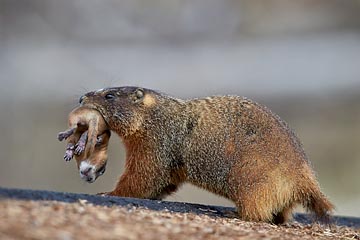
1/500 sec, f8, ISO 640
My other exciting "first" was seeing and photographing a Yellow-Bellied Marmot carrying a pup from one burrow to another. I quickly got some shots from the Jeep shortly after I spotted her, then I set up to photograph from ground level on (hopefully) her next pass. She made four passes while I was there, and this image (above R) is from the only location where the pup's whole face is visible. Note that the mother has a bobbed tail, probably from a close call with a coyote.
Take care and happy shooting.
— James
James Hager Photography :: www.jameshagerphoto.com




